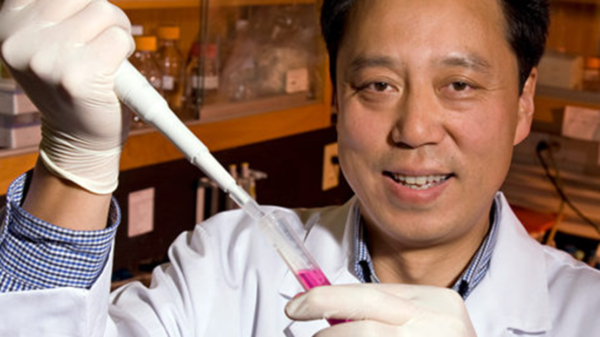

Dr. Wei Yan is University of Nevada, Reno Foundation Professor and Director of Single Cell Genomics & Genome Editing Core Labs at the University of Nevada, Reno School of Medicine. His lab works on genetics and epigenetics of gametogenesis, and epigenetic contribution of gametes to fertilization, early embryonic development and adulthood health. Dr. Yan has published >130 peer-reviewed research articles and book chapters with >6,800 citations (as of April 2019). He is the recipient of the 2009 Society for the Study of Reproduction (SSR) Young Investigator Award, the 2012 American Society of Andrology (ASA) Young Andrologist Award, the 2013 Nevada Healthcare Hero Award for Research and Technology, the 2017 University of Nevada, Reno Outstanding Researcher Award, and the 2018 SSR Research Award. In May 2016, Dr. Yan was named the University of Nevada, Reno Foundation Professor, the highest honor the University bestows upon its faculty. In November 2017, Dr. Yan was elected as a Fellow of the American Association for the Advancement of Science (AAAS). Dr. Yan serves as co-Editor-in-Chief of Biology of Reproduction, the official journal of the SSR. For more information please visit the Yan lab website: www.weiyanlab.com.
What is your connection to contraception?
Our basic research on the regulation of spermiogenesis has revealed that functional disruptions of late spermiogenesis (i.e., after the onset of spermatid elongation) often lead to the production of deformed and/or non-functional sperm and consequently male infertility without causing testis shrinkage. Therefore, targeting late spermiogenesis-specific genes or gene products represents probably an ideal strategy for male non-hormonal contraceptive development. Based on this idea, we embarked on a extensive search for compounds that disrupt the last several steps of spermiogenesis. We have discovered that spermatodeformin 1 (SD1), a natural compound purified from a Chinese herb, targets the last several steps of spermiogenesis, leading to sperm deformation and male infertility in a reversible manner.
How has the sector changed from the time you began working in it to date?
Not much. Investigators have claimed so many times that the male pills would be on the market in couple of years, but the fact is that we have zero compounds that have even entered the Investigational New Drug (IND) status. This has generated “the-boy-who-cried-wolf” effects, which is really not good for the entire sector!
What do you think are the biggest challenges affecting contraception, generally, and male contraception, specifically?
It is long past due that we revisit our strategies for male contraceptive development. Knowledge on the regulation of spermatogenesis is critical; any attempts/approaches based on shallow or partial understanding of sperm development would be destined to fail.
Have these challenges and opportunities evolved over time? If so, how?
Yes. Reproductive health has increasingly been recognized by the public. People have started to appreciate the value of family planning and the effects of gamete (sperm and oocyte) quality on the long-term overall health of offspring. However, studies on these topics are very limited. It is time to emphasize the importance of reproductive health, with a focus on fertility control (i.e., treatment for infertility and contraceptive development).
What are your hopes for the near and far future of male contraception?
Contraceptive development should be a research priority. In the near future, one or two of the most promising lead compounds should be supported to gain the Federal Drug Administration’s (FDA) IND status. In the long run, funding for contraceptive development should be increased and the approaches should not be restricted only to the known models for drug development. Please bear in mind: many life-saving drugs were discovered by accident and their mechanisms of action remained unknown for decades.
What will it take for these to become reality?
Progress in male contraceptive development is really needed, and empty promises or claims should essentially be avoided. Advocacy is critical and thanks to the efforts of both the government (e.g., the NICHD Contraceptive Branch) and private sectors (e.g., MCI), the short- and long-term goals appear to be under development. Of course, a bright future in this area depends on hard work and perseverance of all parties involved.
Are there barriers to prevent these from coming to fruition?
There are many barriers: lack of funding, limited knowledge on spermatogenesis and sperm biology, lack of appreciation of the broader impact of sperm quality on offspring health, defects inherent to the current grant review and award selection system, to name a few.
more recommended stories
 Fentanyl Seizures at Border Continue to Spike, Making San Diego a National Epicenter for Fentanyl Trafficking
Fentanyl Seizures at Border Continue to Spike, Making San Diego a National Epicenter for Fentanyl TraffickingFentanyl Seizures at Border Continue to.
 Utah Man Sentenced for Hate Crime Attack of Three Men
Utah Man Sentenced for Hate Crime Attack of Three MenTuesday, August 8, 2023 A.
 Green Energy Company Biden Hosted At White House Files For Bankruptcy
Green Energy Company Biden Hosted At White House Files For BankruptcyAug 7 (Reuters) – Electric-vehicle parts.
 Former ABC News Reporter Who “Debunked” Pizzagate Pleads Guilty of Possessing Child pδrn
Former ABC News Reporter Who “Debunked” Pizzagate Pleads Guilty of Possessing Child pδrnFriday, July 21, 2023 A former.
 Six Harvard Medical School and an Arkansas mortuary Charged With Trafficking In Stolen Human Remains
Six Harvard Medical School and an Arkansas mortuary Charged With Trafficking In Stolen Human RemainsSCRANTON – The United States.
 Over 300 People Facing Federal Charges For Crimes Committed During Nationwide Demonstrations
Over 300 People Facing Federal Charges For Crimes Committed During Nationwide DemonstrationsThe Department of Justice announced that.
